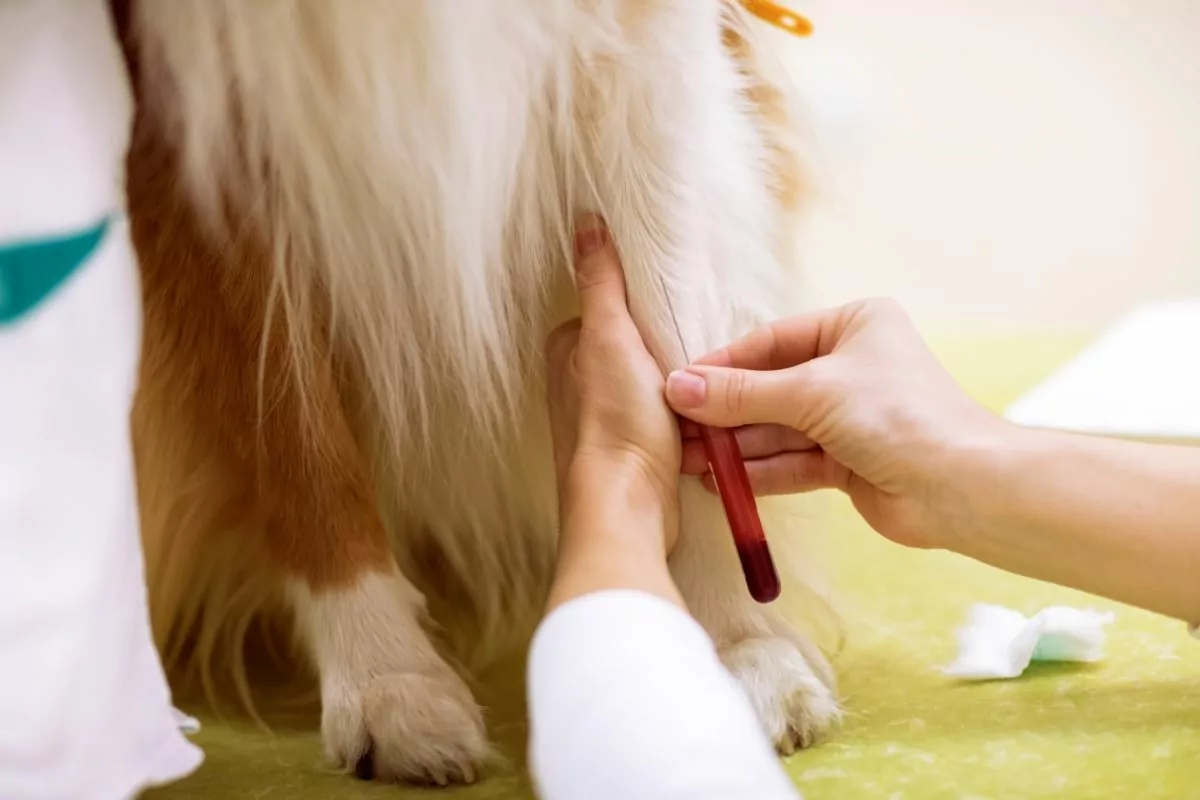What is Allergic Dermatitis in Dogs?
Also known as atopic dermatitis, allergic dermatitis in dogs is a pruritic (itchy) skin condition commonly found in dogs. Unlike humans that react to allergens through hives or nasal issues, dogs most commonly present through skin allergies or gastrointestinal problems.
Dogs will usually start presenting with allergic dermatitis from one to three years. It can be a chronic year-long skin condition or seasonal, presenting more in spring and fall.

What Causes Dry Skin on Dogs?
Allergic dermatitis is a prevalent disease in dogs because it is hereditary and can therefore be found in pure-breed and mixed breed dogs. This is a condition in which dogs are predisposed to present with allergy symptoms after being exposed to otherwise harmless substances (allergens).
Substances in the environment, food, bacterial, and parasitic infections can all lead to skin reactions. These allergens will usually cause dogs to lick, bite and scratch at areas all over their bodies, such as their feet, armpits, groins, ears, and flanks.
This usually leads to drying of those areas. In addition, excessive self-trauma will cause patchy hair loss and reddening of the skin.
Dry skin can also be a symptom in many conditions, such as hypothyroidism (underactive thyroid) or Cushing’s disease (overactive pituitary gland). This would need to be ruled out as a cause of skin issues, via blood testing, before diagnosing atopic dermatitis.
Some of the most common breeds to present with atopic dermatitis include most terriers, Golden Retrievers, Lhasa Apsos, Dalmations, and Bulldogs. However, many other breeds can still suffer.
Allergic reactions in dogs can be caused by the same substances that would cause reactions in humans. These include inhalant substances such as grass, tree, and weed pollen, which would be more seasonal, or year-long substances like dust mites and molds.
Food allergies are not always present from a young age and can develop at any age, despite the dog eating the same food for its entire life. Therefore, an ingredient that is singled out to be an allergen could be present in either good or bad quality food. However, more premium-quality foods tend to avoid food fillers known as common allergens.
Dogs that will present with flea allergies are not allergic to the flea itself but to a protein in the flea’s saliva. It is much more common for dogs with occasional and limited exposure to be allergic than dogs constantly ridden in fleas. One bite can cause a reaction that can last for five to seven days.
Skin naturally has normal Staphylococcus (Staph) bacteria on its surface. A dog’s immune system can have a bacterial hypersensitivity to this. However, it is more likely to occur when other concurrent conditions such as hypothyroidism or other allergies are present, such as inhalant or flea allergies.
To diagnose bacterial hypersensitivity, your vet will examine biopsied samples and bacterial cultures under a microscope.
Symptoms of Allergic Dermatitis in Dogs
- Localized areas of itching and biting such as the feet, face, ears, or around the tail and rump area
- Excessive scratching and biting across the entire body
- Rubbing faces along carpets
- Dry or oily skin
- Saliva staining from excessive licking
- Reddened and hot ears or areas of the skin (hot spots)
- Chronic bacterial or yeast (Malassezia) ear infections
- Chronic skin infections
- Hair loss
- Generalized foul odor
- Rashes on belly
- Poor coat texture
- Scabbing and open wounds
How are Allergies in Dogs Diagnosed?
Food Allergies
Your vet will usually diagnose food allergies through a food trial of a hypoallergenic diet as other diagnostics are inappropriate. If a vast improvement and reduction in symptoms are shown on this diet, it would indicate an underlying food allergy over inhalation allergies. The trial will usually need to take place over a minimum of 8 weeks, where no other type of food is allowed.
If the dog shows significant improvement in skin quality by the end of the trial, they can continue on that food as long as it is a balanced diet. Sometimes other foods may be reintroduced back into the diet to assess if they are individually causing any reactions. If they do, they have known allergens.
Inhalation and Contact Allergies
Intradermal allergy testing can also be carried out to identify specific airborne allergens. This is typically carried out under sedation or general anesthesia. A small number of common allergens are injected under the skin, usually in the abdomen or thorax regions, which is clipped of fur before testing.
When an allergen is identified as positive for a reaction, it will appear as a visible swelling over the injection site and look hives. Typically this will appear within 20 minutes of the injection. If no swelling occurs, it is then assumed the patient is not allergic to that specific allergen.
If a female is pregnant or in heat, they should not be tested as there can be a hormonal impact on the results. Dogs should not be bathed for five days before testing. If there have been recent treatments of injectable, topical, or oral steroids, antihistamines, or essential fatty acids, testing should be delayed.
Blood testing is performed to look for antigen-induced antibodies caused by inhalation allergies. It is a helpful diagnostic tool as it is relatively quickly performed without needing the dog sedated and can be done with one blood sample.
However, these results can commonly have false positives which cannot be confirmed with intradermal skin testing. Therefore, it can cause the validity of the testing to be questioned. Although, if a dog cannot undergo intradermal skin testing, this is useful to assist a diagnosis.
Atopic dermatitis will only be diagnosed when other diseases, such as flea allergy dermatitis, are ruled out. Then, basic skin work-ups such as flea combing, skin scraping, and hair plucking will be undertaken.

Other Conditions
Both internal and external factors will result in healthy skin and coat. Before an allergic dermatitis diagnosis, dogs with comorbidities, such as thyroid diseases, need to be considered.
Dogs will most commonly present with hypothyroidism (underactive thyroid), resulting in poor skin and coat quality. Further indications of hypothyroidism include dull and brittle hair and oily or dry skin.
As these are also common symptoms of atopic dermatitis, blood testing to check for a lowered level of the T4 hormone would need to be carried out to rule this out as a factor before exploring an allergic dermatitis diagnosis. If this comes back lowered, further testing to check for other thyroid hormones will likely be carried out.
Unfortunately, as symptoms of allergic dermatitis in dogs are very similar to other conditions, it can be challenging to diagnose. Many times it will be a process of elimination. Veterinarians will need to look at a comprehensive medical history before making any definitive diagnosis.
They would first consider the dog’s age, the season in the year, and any possible new allergens in the diet that could be leading to reactions. Areas of the body most affected, such as the ears, feet, or armpits, and whether the breed of dog is likely to have inherited skin conditions will also be considered.
Once all factors have been considered, they will use all tests carried out and a complete picture of the medical history to diagnose.
Treatment for Allergic Dermatitis in Dogs
Environmental Control
If allergens are known through testing, avoiding these is the best form of treatment. However, in most cases (up to 99%), avoidance is ineffective and unrealistic due to outside influences being unable to be controlled.
Dehumidifiers and air purifiers will reduce exposure to molds, dust, and pollen in the environment. In addition, the use of air conditioning as an alternative to opening windows will reduce the number of airborne allergens.
Hypoallergenic Diets
When caused by food reactions, allergic dermatitis can be controlled through correct diet choices. As allergies develop through exposure, specialty veterinary diets, such as hypoallergenic, have been developed to integrate proteins and carbohydrates in ways never presented in commercially bought dog food.
Hypoallergenic diets are designed to use hydrolyzed proteins. This is where the protein source is synthetically reduced to smaller fragments. In theory, this will ensure that the potential allergen is too small to be recognized and will not trigger an immune response.
Dairy, beef, and wheat are accountable for 80% of all dietary allergies in food. Hypoallergenic food will avoid these and include duck, kangaroo, and fish proteins instead. Alternative carbohydrates will consist of potatoes, peas, and sweet potatoes.
Supplements
Supplementation of Omega-3 and Omega-6 essential fatty acids will improve the skin’s overall health, as they have natural anti-inflammatory and antioxidative agents. Inclusion of these in diets is not harmful and has minimal side effects. These can be located in fish oils or plants containing gamma-linolenic acid and differ from supplements to assist coats.
However, diet change and essential fatty acid inclusion in diet can take a minimum of 60 days to improve significantly. Although, many dogs will manage their symptoms well with diet change alone.
Flea Prevention
Veterinarians will use medications to assist in preventing allergic outbreaks. Firstly, if it is likely, or is known, that fleas are the allergen, then a strict flea prevention schedule needs to be adhered to. You can use antiparasitic products such as Advantage, Frontline, and Comfortis for the best control.
Antifungal and Antibiotic Medications
Secondary skin infections that can develop will also need to be treated using antibiotics. Similarly, antifungal medications can be used with longer-term treatments when secondary yeast infections appear.
Medicated Shampoos
Medicated shampoos can be used to assist in reducing outbreaks of skin irritations. Products such as Malaseb include anti-inflammatories and antifungal compounds to reduce inflammation while soothing and treating the skin. Other shampoos also include antimicrobials.
Medicated shampoos are designed to allow the skin to be bathed more frequently than usually recommended while not drying out the skin and causing further issues.
Antihistamines
Medications such as Benadryl, Chlortrimenton, and Claratin are the best antihistamines for dogs with skin allergies. Overall, they are a safe and inexpensive treatment, with minimal associated side effects (mainly grogginess).
Some dogs will show excellent control of symptoms with antihistamines, but they have little effect on others. Therefore, a minimum of three different types should be used before stopping their use. When used in conjunction with essential fatty acids, antihistamines will control 10-25% of cases caused by airborne allergens.
Corticosteroids and Immunosuppressants
Longer-term medications, such as corticosteroids and immunosuppressants, will reduce itching by reducing inflammation. However, these medications can have considerable side effects, so they should be used more stringently.
Steroid use should only be considered if used for a short time as a dog is in considerable discomfort or the quantity given over a more extended period is significantly reduced. Common steroids include Prednisolone and Dexamethasone.
This is due to the side effects. Common side effects are increased polyuria and polydipsia (increased urination and drinking) and increased appetite. Dogs can also present with behavioral changes, including being more nervous, restless, and aggressive due to diet and sudden changes or loud noises.
Longer-term side effects of steroid use include diabetes and reduced immune system response to infection. However, the only effective management of allergic dermatitis in some dogs is through long-term, low-dose corticosteroid therapy. Due to the long-term side effects, this should be a last resort course of treatment.
Immunosuppressants such as Cyclosporine (Atopica) work similarly to Corticosteroids by reducing inflammation linked to skin allergies and declining immune response. But, again, these can be either a longer or shorter-term treatment.
However, this medication is priced significantly higher, and therefore larger breeds may be excluded from longer-term use due to monetary constraints.
Side effects are also significant and similar to steroid use. They can range from gastrointestinal upset to an increased risk of infections due to a weakened immune system.
Another form of immunotherapy is allergy shots (allergen-specific immunotherapy). They are a very safe form of treatment but are very slow acting. As these rely on the immune system, they can take six to twelve months to be effective.
This treatment first needs to have allergens identified and isolated for individual dog-specific immunotherapy to be manufactured. Then, a hyposensitization injection is formulated from these offending antigens.
In cases of atopic dermatitis, 60-70% of dogs respond to allergen-specific immunotherapy. However, this treatment option is only available to dogs with airborne allergens. These injections are given over weeks to months until immunity is developed. Subsequently, boosters for life will be needed to maintain immunity.
Thyroid Treatments
With dogs that have been diagnosed with hypothyroidism, once they are on the correct course and dose of medication, their skin and fur issues should start to resolve and return to how they were before.
Hypothyroidism is treated with daily doses of thyroxine, which is a synthetic thyroid hormone. Regular and routine blood testing is then required to assess the efficacy of the dosage to ensure that no adjustments are needed to maintain an average level in the system.

Conclusion
With dogs being able to manage symptoms through diet, such as eating hypoallergenic food, if a dog is likely to have access to known allergic proteins or carbohydrates, it would be challenging to prevent flare-ups.
However, as medications can cause side effects, the dog owner would have to decide if long-term medicines would be better for patient comfort overall.
The treatment option with the highest success rate is allergen-specific immunotherapy. However, as this only works to desensitize airborne allergens, it is not effective for allergens detected in food.
While allergic dermatitis can be very difficult to diagnose as it can present as many possible diseases, it can be easily controlled and managed once proper treatment is found. While there are many treatment options, many can be detrimental to the patient’s overall health, while others may not be as effective.
Moreover, conducting blood tests, allergy testing, and diet trials can be very expensive for owners to get a conclusive diagnosis. If antihistamines are known to work the majority of the time, they may be more likely to continue on this course of treatment.
To successfully treat and manage allergic dermatitis in dogs, a multi-modal system of treatments is usually necessary to prevent flare-ups. However, it can be very frustrating for dog owners and can lead to reduced compliance and, therefore, more discomfort over time.
However, patients’ allergy symptoms can be controlled well when adequately diagnosed by a veterinarian, and a treatment plan is followed correctly!
